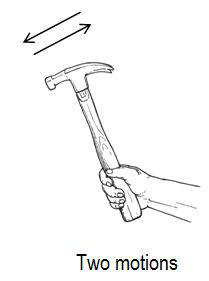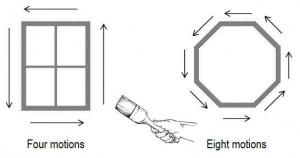A motion is a movement or exertion made by a major joint or body link. From the perspective of preventing musculoskeletal disorders, the concern is for the number of loads on, or slides of, a tendon and is the primary criterion for quantifying the motions of a task.
A good rule of thumb is that a motion occurs every time the body part in question changes directions. Thus, the extremely common flexion/extension cycle involves two motions.
From an efficiency standpoint, this approach also works well. It provides a standardized way to compare work methods and provides insights in a way that time study alone does not.
 |
 |
Motions are quantified by observing and counting, either directly or by viewing a video clip. Counting motions can often be a very simple undertaking, since it can be done by the unaided eye and counting to oneself. On the other hand, counting can sometime be quite difficult, since in many tasks it can be troublesome to determine exactly what constitutes a motion.
Getting in the habit of observing motions in this manner helps to identify wasted steps and better vs. worse methods, even if done mentally without tallying the actual counts.
Steps
- Identify the joint or body link in question when observing a task — the wrist, elbow, or back, left versus right, and so on. Focus only on that specific joint and ignore everything else, guarding against becoming distracted by other movements and the task itself.
- Video the task whenever possible. Videos can (a) help you to focus, (b) enable use of slow motion to detect rapid motions, such as is common with the wrist, and (c) permit multiple reviews of the same sequence or different sequences to help increase accuracy.
- Identify the steps of the job. It is often useful to document the motions for each step in the process of obtaining a count for the entire task.
- Count the number of times the body link in question changes direction.
- Include exertions, even if no movement is detected. For example, attempting to lift a car with a single effort would be considered a motion, even though the car was not moved.
- Ignore wiggles and minor movements of the joint that are less than ±15°, particularly if they are unrelated to the task. However, include these minor movements if there is some other reason for doing so.
- Count complete circular motions as four motions. Torque motions should be counted separately
- Document these specific definitions and the assumptions made for the task or workplace at hand. Many choices are arbitrary, but, once made, should become a standard that is followed. Furthermore, the documentation permits others to interpret the results.
For more details on counting motions, see MacLeod D., 2012, The Rules of Work, Second Edition, pp. 126-129, Taylor & Francis.
